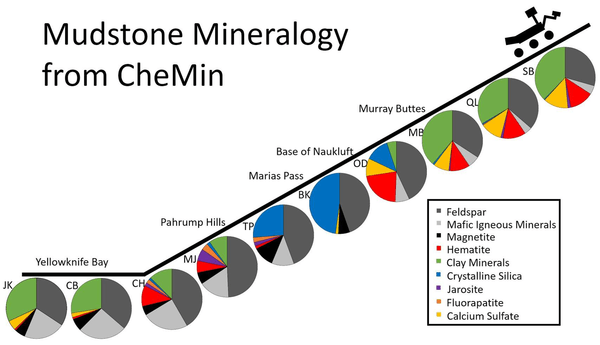Mudstone
Mudstone, a type of mudrock, is a fine-grained sedimentary rock whose original constituents were clays or muds. Grain size is up to 0.063 millimetres (0.0025 in)[1] with individual grains too small to be distinguished without a microscope. With increased pressure over time, the platy clay minerals may become aligned, with the appearance of fissility or parallel layering. This finely bedded material that splits readily into thin layers is called shale, as distinct from mudstone. The lack of fissility or layering in mudstone may be due to either original texture or the disruption of layering by burrowing organisms in the sediment prior to lithification. Mud rocks such as mudstone and shale account for some 65% of all sedimentary rocks. Mudstone looks like hardened clay and, depending upon the circumstances under which it was formed, it may show cracks or fissures, like a sun-baked clay deposit.[2]
Mudstone can be separated into these categories:
Carbonate mudstone

In the Dunham classification (Dunham, 1962[3]) system of limestones, a mudstone is defined as a mud-supported carbonate rock that contains less than 10% grains. Most recently, this definition has been clarified as a matrix-supported carbonate-dominated rock composed of more than 90% carbonate mud (<63 μm) component.[4]
The identification of carbonate mudstone

A recent study by Lokier and Al Junaibi (2016)[4] has highlighted that the most common problems encountered when describing a mudstone is to incorrectly estimate the volume of 'grains' in the sample - in consequence, misidentifying mudstone as wackestone and vice versa. The original Dunham classification (1962)[3] defined the matrix as clay and fine-silt size sediment <20 μm in diameter. This definition was redefined by Embry & Klovan (1971[5]) to a grain size of less than or equal to 30 μm. Wright (1992[6]) proposed a further increase to the upper limit for the matrix size in order to bring it into line with the upper limit for silt (63 μm).
Mudstone mineralogy on Mars

NOTE: JK for "John Klein", CB for "Cumberland". CH for "Confidence Hills", MJ for "Mojave", TP for "Telegraph Peak", BK for "Buckskin", OD for "Oudam", MB for "Marimba", QL for "Quela", and SB for Sebina. (For locations/drillings, see image)
On December 13, 2016, NASA reported further evidence supporting habitability on the planet Mars as the Curiosity rover climbed higher, studying younger layers, on Mount Sharp.[8] Also reported, the very soluble element boron was detected for the first time on Mars.[8] In June 2018, NASA reported that Curiosity had detected kerogen and other complex organic compounds from mudstone rocks approximately 3.5 billion years old.[9][10][11][12][13][14][15][16]
See also
References
- Verruijt, Arnold (2018). An Introduction to Soil Mechanics, Theory and Applications of Transport in Porous Media. Springer. pp. 13–14. ISBN 978-3-319-61185-3.
- Blatt, H., and R.J. Tracy, 1996, Petrology. New York, New York, W. H. Freeman, 2nd ed, 529 pp. ISBN 0-7167-2438-3
- Dunham, R.J., 1962. Classification of carbonate rocks according to depositional texture. In: W.E. Ham (Ed.), Classification of Carbonate Rocks. American Association of Petroleum Geologists Memoir. American Association of Petroleum Geologists, Tulsa, Oklahoma, pp. 108-121.
- Lokier, Stephen W.; Al Junaibi, Mariam (2016-12-01). "The petrographic description of carbonate facies: are we all speaking the same language?". Sedimentology. 63 (7): 1843–1885. doi:10.1111/sed.12293. ISSN 1365-3091.
- Embry, Ashton F.; Klovan, J. Edward (1971-12-01). "A late Devonian reef tract on northeastern Banks Island, N.W.T". Bulletin of Canadian Petroleum Geology. 19 (4): 730–781. ISSN 0007-4802.
- Wright, V. P. (1992-03-01). "A revised classification of limestones". Sedimentary Geology. 76 (3): 177–185. doi:10.1016/0037-0738(92)90082-3.
- Staff (December 13, 2016). "PIA21146: Mudstone Mineralogy from Curiosity's CheMin, 2013 to 2016". NASA. Retrieved December 16, 2016.
- Cantillo, Laurie; Brown, Dwayne; Webster, Guy; Agle, DC; Tabor, Abigail; Mullane, Laura (December 13, 2016). "Mars Rock-Ingredient Stew Seen as Plus for Habitability". NASA. Retrieved December 14, 2016.
- Brown, Dwayne; Wendel, JoAnna; Steigerwald, Bill; Jones, Nancy; Good, Andrew (June 7, 2018). "Release 18-050 - NASA Finds Ancient Organic Material, Mysterious Methane on Mars". NASA. Retrieved June 11, 2018.
- NASA (June 7, 2018). "Ancient Organics Discovered on Mars - video (03:17)". NASA. Retrieved June 11, 2018.
- Wall, Mike (June 7, 2018). "Curiosity Rover Finds Ancient 'Building Blocks for Life' on Mars". Space.com. Retrieved June 11, 2018.
- Chang, Kenneth (June 7, 2018). "Life on Mars? Rover's Latest Discovery Puts It 'On the Table' - The identification of organic molecules in rocks on the red planet does not necessarily point to life there, past or present, but does indicate that some of the building blocks were present". The New York Times. Retrieved June 11, 2018.
- Voosen, Paul (June 7, 2018). "NASA rover hits organic pay dirt on Mars". Science. Retrieved June 11, 2018.
- ten Kate, Inge Loes (June 8, 2018). "Organic molecules on Mars". Science. 360 (6393): 1068–1069. doi:10.1126/science.aat2662. PMID 29880670.
- Webster, Christopher R.; et al. (June 8, 2018). "Background levels of methane in Mars' atmosphere show strong seasonal variations". Science. 360 (6393): 1093–1096. doi:10.1126/science.aaq0131. PMID 29880682.
- Eigenbrode, Jennifer L.; et al. (June 8, 2018). "Organic matter preserved in 3-billion-year-old mudstones at Gale crater, Mars". Science. 360 (6393): 1096–1101. doi:10.1126/science.aas9185. PMID 29880683.